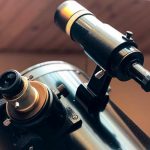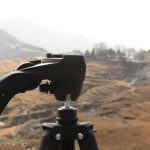Telescope Filters Guide
Imagine what it would be like to take a passing interest in the stars to a full-blown astronomy hobby. Many people have fallen in love with the idea of viewing the night sky and have gone on to become keen amateur astronomists. You could do the same if it interests you, all you need is a basic set-up, and you’re ready to begin the journey.
When you put your stargazing kit together, don’t forget to add a crucial part that many observers forget; the filters. Without the best and correct filters, you’ll not get anywhere near a first-rate experience.
First of all, this telescope filters guide will give you a complete rundown of how filters work and why they are 100% useful.
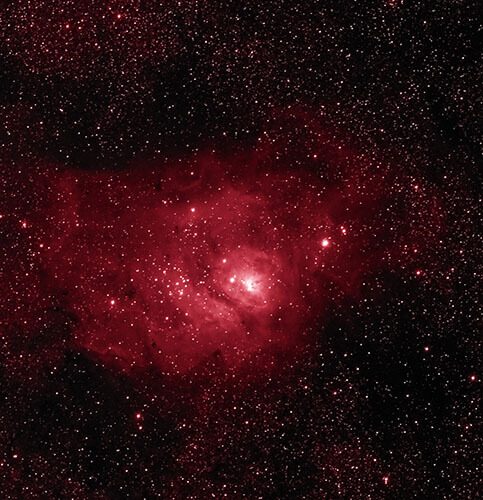
What Are Filters Used For And How They Work
If you have any experience with cameras and photography, then you’ll already know a good deal about filters. Telescope filters work similarly; they eliminate unwanted colors or light wavelengths, improving contrast and providing more enhanced detail.
For example, filters block specific light wavelengths and allow different ones to pass through; they can also determine how much light reaches our eyes (percentage transmission). If you were to view our moon, a filter would be capable of reducing glare, so what you’re trying to view would appear much more evident.
A different kind of filter would only allow specific colors to pass through, thereby improving the contrast so when observing planets, it becomes much easier to make out exact details.
Needless to say, the Moon and planets, etc. are not the same; therefore, we need specific filters. For example, you’ll need a different filter to view Mars than you would to view Venus.
Light Pollution Filters
Astronomers will find the usual culprit of unwanted light is pollution. Many amateurs view the night sky in their backyards, and sodium lighting pollution can be a nuisance, as can light from neighboring homes.
Light pollution filters offer an excellent solution to this problem; although they will not eliminate all sources of light pollution, they are a fantastic asset.
Filters are typically straightforward to use and are threaded, so all an astronomer has to do is screw a filter onto their eyepieces.
Telescope Filter Types
Wratten Number System
Wratten numbers are a way of differentiating color filters. The number denotes the filter color, and the letter relates to the filter strength. For example, 80A – 80D are blue filters going from A, the weakest, to D, the strongest.
Observing The Moon – Polarizing Filters
Let’s face it, the first thing most amateur astronomers want to do is observe the moon; naturally, it’s a hugely exciting prospect for anyone; however, as they soon discover, the moon is exceptionally bright.
By far, the best way to combat the brightness levels is by using a polarizing filter. However, before you jump ahead and buy one, you need to know two filter types.
- Fixed Brightness Moon Filter
- Variable Moon Filter
Fixed Brightness Moon Filter
As the name suggests, this filter will only allow a certain amount of light to come through based on a percentage value; for example, a 13% filter will allow 13% of the light that strikes the telescope’s mirror to pass through; a 25% filter will allow 25% of the light through, etc.
Typically the smaller your telescope’s aperture, the more light you can allow through; therefore, you would choose a filter with a higher percentage, such as the 25% filter.
An excellent example of this type and percentage filter would be:
Orion 05598 1.25-Inch 25 Percent Transmission Moon Filter
If you own a telescope with a wider aperture, for example, over 5”, you will be much better choosing the 13% filter such as the:
Meade Instruments Series 4000 MoonFilter: ND96, Black – 7531
Variable Moon Filter
Admittedly this kind of filter might make the better choice, especially if you’re into observing the moon in a big way.
These filters let you choose how much light you want; for example, you might need more light when observing the moon in its crescent stage and less on nights when the moon is full.
One of the very best variable polarizing filters is the one we recommend below. You can adjust the amount of light transmission from 1% to 40% simply by rotating the eyepiece filter housing. This filter will allow you much finer control of the image brightness.
Orion 5560 1.25-Inch Variable Polarizing Filter
Solar Filters
While looking directly at the sun is incredibly damaging to the eyes, you can view the sun safely when you prepare correctly. Should you want to view flares or sunspots, you can safely view them providing you have a method of reducing powerful sunlight.
Filters are typically threaded to screw onto your eyepiece, but professional solar filters don’t work the same way.
The real purpose of a solar filter is to block the majority of the sun’s light before it strikes the primary optic to prevent the sunlight from being more focused and concentrated, damaging the filter and leading to severe eye injuries.
So, the best solar filters fit over the front of telescopes and cover the scope’s aperture, thereby protecting the primary optic.
An excellent example of a sun filter is this:
Orion Safety Solar Filter
Please remember to never look directly at the sun through your telescope. You will cause severe and permanent damage to your eyes.
Best Telescope Filters for Viewing Planets
Picking filters for viewing planets comes down to choosing filters that offer the most contrast; to do that, we need to understand different color filters will not produce the same effect.
For an excellent example of this, when you’re viewing Mars simply to obtain a perfect general contrast, you’d choose a green filter; however, if you wanted to make the deserts brighter, choose a red filter.
Below is a list of the best color filters when you want to obtain more detail of the brightest of planets.
Click the filter color to find more information on each filter. The Filter for viewing:
- Mars & Venus: Astromania 1.25″ Color/Planetary Filter – #25 Red
- Jupiter & Venus: Astromania 1.25″ Color/Planetary Filter – #38A Dark Blue
- Moon, Jupiter & Saturn: Astromania 1.25″ Color/Planetary Filter – #80A Blue
Deep Sky Filters
Chromatic aberration filters
There is a phenomenon when you look at stars through your telescope known as chromatic aberration (CA). According to the laws of physics, white light passing through a telescope’s lens will cause blue light to bend at different angles than red light; consequently, they will not be at the exact same location when you view them.
In other words, the colors around stars look blurred through your telescope unless you use a chromatic aberration filter. These filters work by reducing the violet light that comes into your eyepiece.
An excellent filter to reduce CA is the Baader Planetarium Semi APO Filter 1.25″ FSAPO-1
Narrowband Astronomy Filters
One more specialized telescope filter is a narrowband filter, and they are beneficial when observing objects such as nebulae, and we are looking to achieve more detailed views.
As the name implies, this type of filter allows only narrow light wavelengths to pass through; somewhere in the region of only 3nm (nanometers) of light.
Using narrowband filters will also reduce sky glow which helps darken the background; however, they don’t undermine your nebulae viewing.
Another reason for using one of these filters is that they bring faint or even invisible nebulae into detail, increasing brightness and contrast.
Lagoon Nebula, Swan Nebula, and Orion Nebula are lovely viewed through a narrowband filter.
Line Filters
Whereas narrowband filters will pass emission lines of Oxygen 111 (O111), Hydrogen Best (H-Beta), and wavelengths between those two, Line filters only transmit O111 or H-Beta lines.
So when would you use O111 and H-Beta line filters?
An O111 filter is a brilliant choice if you want to observe M8, M33, Helix Nebulae, and the Veil. The difference between not using one of these filters and when you use one is astonishing.
You may use H-Beta filters for viewing bright nebulae; however, the results you’ll achieve will be hit and miss; they work on some but not others.
However, if you own a large aperture telescope, over 8″, let’s say the H-Beta filter works wonders for viewing faint nebulae. For example, try viewing North America Nebulae, Cocoon, Horsehead, California, M42, and M43 through an H-Beta filter, and you’ll see what we mean.
Conclusion – Buying A Set Of Filters
As we mentioned at the beginning of the article, telescope filters are crucial pieces of equipment and relatively inexpensive for how much they’ll enhance your viewing pleasure.
Choose a light pollution filter, to begin with, unless you live somewhere unaffected by city lights. The following filter on your list should be the moon filter, closely followed by color filters to help you observe the planets.


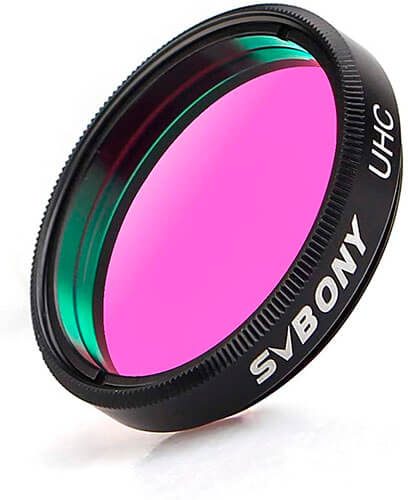
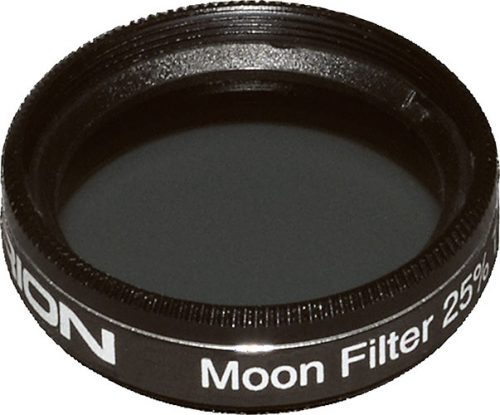
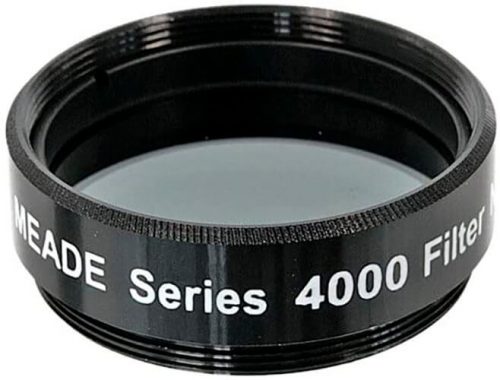



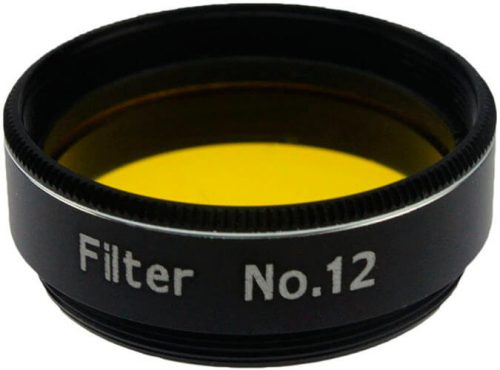
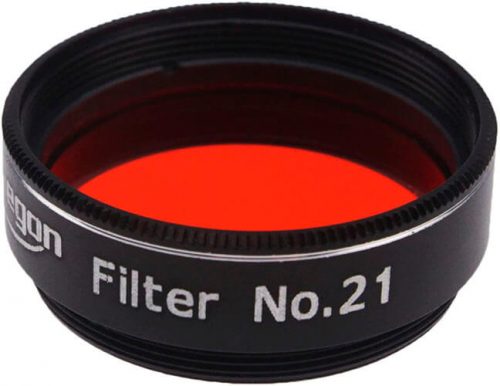
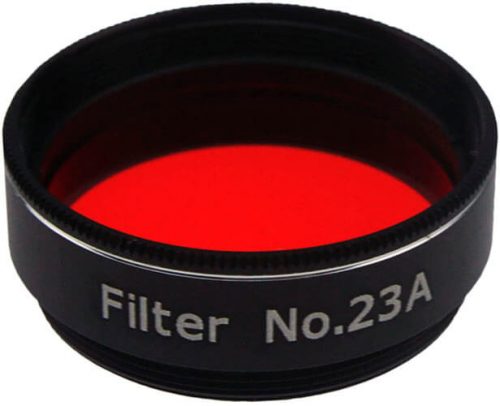




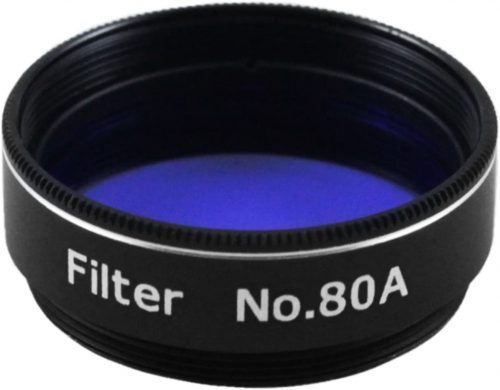





![Best Barlow Lens For Your Telescope [2021]](https://likehubble.com/wp-content/uploads/2021/01/best-barlow-lens-150x150.jpg)
